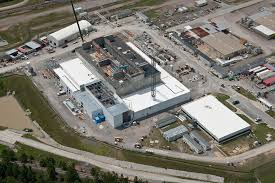
The Department of Energy could levy up to $33 million in disincentive fees against Parsons Government Services for the contractor’s failure to control costs and meet deadlines at the Savannah River Site’s $2.3 billion Salt Waste Processing Facility (SWPF), the agency said this month.
Parsons is pushing back, saying the agency is not acting in good faith and is misstating the terms of their contract.
Parsons is tasked to design, build, test, and start up SWPF no later than January 2021. The contractor is also expected to operate the facility for one year before turning it over to Savannah River’s liquid waste contractor. Late last year, Parsons and DOE pushed startup of the plant to December 2019 from December 2018.
In a March 19 letter obtained by Weapons Complex Monitor, DOE Contracting Officer Justin Speering wrote that Parsons is “rapidly approaching” the contract value for commissioning — testing the facility to ensure it is ready for operations.
The Energy Department thought commissioning SWPF would cost between $350 million and $380 million. Under Parsons’ contract, DOE and the company will equally divide the cost of overruns. In this case, the overruns would total about $15 million for the contractor, Speering wrote to Frank Sheppard, Parsons senior vice president and SWPF project manager.
Speering’s letter does not state what has caused cost overruns.
The federal government will take an additional $3 million, capped at $18 million, for every month Parsons fails to submit a declaration of readiness to proceed so the Energy Department can start its operational readiness review at the SWPF. Parsons is supposed to submit its readiness declaration by Sunday.
In an undated, unsigned response letter also obtained by Weapons Complex Monitor, Parsons wrote that “[t]here is no contractual basis for such withholdings in this cost reimbursable contract.” The contractor added that the final fee determinations are to be set at the end of the incentive term, rather than in the middle of the contract. Furthermore, any disincentive fees retained by DOE must be refunded back to Parsons once the company issues an updated project baseline for SWPF testing and operations, the company said.
The contractor added that DOE is attempting to levy fines without first addressing Parsons’ requests for equitable adjustments (REA). In short, Parsons said it has asked DOE to reimburse the company multiple times for various actions that led to cost overruns and delays. Those claims total about $100 million, according to the letter.
In one example, Parsons said DOE recognized there were equipment issues at SWPF, causing the agency to push back the projected start of operations by a full year. However, the letter says the Energy Department did not take those issues into account when it announced that it was seeking disincentive fees.
In another example, Parsons submitted its final documented safety analysis for the plant to DOE in May 2017. The federal agency said it would provide comments on the document within 30 days, but Parsons said DOE “grossly exceeded” that deadline, which then pushed back publication of its final safety evaluation report. That delay “significantly increased project costs,” Parsons wrote.
Parsons said it accrued other costs due to “deliberate DOE disruption and delays in resuming the Deliberate Startup of Operations from a Conduct of Operations pause.” It is unclear when that pause occurred, but Parsons said it caused “significant cost and schedule impacts to the project.”
Finally, the contractor said several weather-related delays throughout the commissioning phase have caused cost and schedule impacts.
The 140,000-square-foot Salt Waste Processing Facility is intended to process roughly 30 million gallons of radioactive salt waste stored in Cold War-era, underground waste tanks at Savannah River. Parsons was hired in 2002 to build the facility and run it for a year.
The SWPF will be a larger-scale version of the SRS salt waste pilot treatment process, and would remove cesium and other components from the salt waste. Those components will go to the nearby Defense Waste Processing Facility (DWPF) for processing, and the remaining salt waste will be sent to permanent storage elsewhere on-site.
About a year ago, Parsons and DOE had another spat over SWPF startup. The Energy Department accused Parsons in March 2018 of “deteriorating” performance at the facility. In a notice, the agency said its contractor had not followed safety protocols and had replaced key personnel without proper federal approval. In a response the following month, Parsons said the department had mischaracterized its performance.
The two sides agreed that Parsons would come up with a new project baseline for the facility, which could include costs and schedules, leading up to the start of operations. In an emailed response to questions on Thursday, Parsons Government Services Executive Vice President Christian Alexander wrote that the new baseline should be finalized within 60 days.
An SRS spokesperson wrote via email, “All actions the Department of Energy has taken are within the terms and conditions of the current Salt Waste Processing Facility contract.”